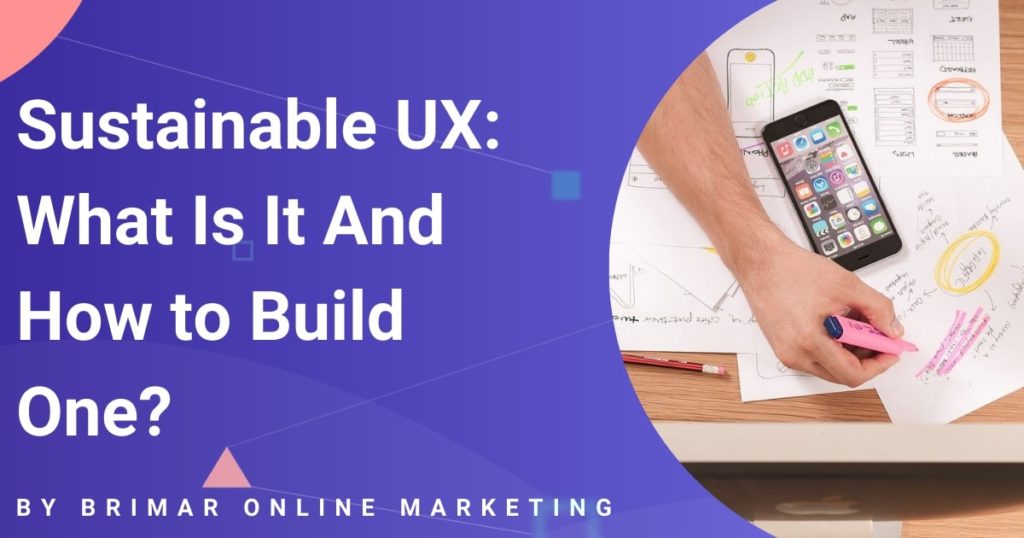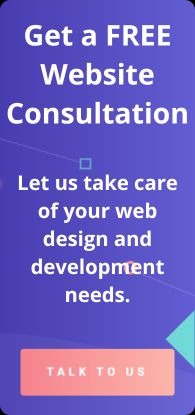
Today the word “sustainability” is widely used to describe processes, resources, and activities.
Humanity avoids the depletion of natural resources to maintain an ecological balance that prevents the poor quality of life in modern society.
It has three dimensions: social, economic, and environmental.
This is how sustainable UX is born.
Want to know more about it?
Keep reading.
What is Sustainable UX? Sustainability + Design
To understand what is sustainable UX or sustainable User Experience, it is essential to understand the concepts before using them.
What is sustainability?
What is design?
How can these two live in harmony?
- Sustainability: “The idea that goods and services should be produced in such a way that irreplaceable resources are not used and the environment is not polluted”; “The ability to stay at a certain level for a certain amount of time
- Design: “Create, project, execute or build according to plan”; “It’s a process of imagining and designing objects, interactive systems, buildings, vehicles and more. It’s user-centric.”
Get a FREE Website Consultation
Let us take care of your web design and development needs so you can focus on your business. We can handle new websites, landing pages, website redesign, and even maintenance.
Contact us today to get a free website consultation!
Sustainable Design
By combining these two concepts, we get a great idea of sustainable design, which considers its impact on the environment without looking at the consumer as a buyer and a profitable business.
It is a project theory that aims to reduce the consumption and surplus of non-renewable resources, reduce waste, and create healthy, productive ecosystems.
The user is one if not an essential factor to consider when creating a product, but we must do better and do a lot more, as well as many other factors like managing stock with the help of WooCommerce to show stock quantity.
Sometimes, when designing a product, we forget its life after throwing it away, turning it into sheer trash.
So, we need to rethink this concept and make it broader and more sophisticated.
There are many creative ways to do this, from subtle environmental announcements to friendly animations and CO2 reduction products.
Also, consider developing digital technologies that promote green energy, reduced energy, inclusion, and affordability.
First, you can use animations and illustrations to create reminders of the consumption of environmentally friendly materials and everyday environmental motifs in the app.
Second, it enables users to learn more about environmental problems and solve them right in your UX project.
Finally, you can create a “sustainable environment” for the user of your product.
Sustainability and User Experience
As designers, our projects provide an opportunity to combine pressing global issues with specific provisions and product or service instances.
The project’s boundaries allow us to find tangible solutions to abstract problems.
This is not only the case for projects focused on sustainable design. Every project is about sustainability.
If we consider sustainability as a factor in the design phase, the limitations of a particular product give designers the space to develop concrete solutions to abstract problems.
It can be applied in product manufacturing, post-processing, and user experience.
We can allow consumers to participate actively by integrating and shaping sustainable synergies.
We can even expand the definition of what we call the user experience.
For example, although we care a lot about the ‘unpacking experience,’ green design must also consider the ‘re-use experience’ of dismantling a product at the end of its life.
Innovating on User Research Protocol
These traditional things and resources in their current form have undoubtedly lessened their impact on the final design.
You could even say that they have now become a commodity.
Even collecting new metrics like Net Promoter Scores and affected project data seemed to have a minimal additional impact.
They did not provide an overview of product performance with the new green awareness of Zeitgeist.
As a researcher, I propose to start research in addition to the traditional data used, online advertisers or affected data, and to include data based on environmentally friendly consumption.
This is an essential indicator of the user’s purchasing decisions and will continue to grow in the coming years.
Ultimately, I realized that users need value for money in a weak economy.
Cell phone package costs aside, users are frustrated that they face problems such as non-payment or environmentally friendly issues and are easily destroyed after purchasing a cell phone.
Those were the fundamental problems of the day.
It doesn’t matter if it took three or four steps to open the music player or if the user wanted to swipe right or down to access the app.
The member I noticed was a 22-year-old user from South Asia who said that the preference for his mobile phones belonged to a company that respects the environment.
He noticed that many of these “useless” phones ended up in the part of the world where his parents were growing up.
He was also impressed that his Nokia phone contained recycling and other information that showed his commitment to sustainability.
But, first, other mobile phone companies would not have the option if products were not built for more than five months.
The feeling that the products should last a long time came up in many more interactions, and I figured out how to deal with it.
I realized that this solution is a solution that designers cannot add to and that user research can consider their realities.
This is, in fact, one of the fundamentals of sustainable UX.
Conscious Creations
One of the biggest challenges facing a single planetary society is the amount of waste generated.
An estimated 3.5 million tonnes of plastic and other solid waste are estimated daily.
For this reason, it’s essential to start creating not only to sell or excite your audience but also to remember the impact each type of product can have.
Durability
Many products are discarded due to insufficient storage time.
That’s why we must buy the same items repeatedly or often- because we know they won’t last long.
This is an opportunity for brands to sell more, and some of them consciously use this “buy-back tactic” to attract users to their products and publications.
However, we must develop durable products that users/consumers can trust to be responsible, informed, and reverse wasteful trends.
Resources
The resources used to produce them are among the most critical factors in reducing waste and creating more sustainable products and solutions.
Therefore, we must invest in greener materials and avoid using plastics where possible.
Let’s never forget that our role as designers is to give people the best experience and products, not just the short time they spend.
Environment-Friendly Solutions
It isn’t easy to talk about sustainability, much less the environment, because one of the key sustainability factors is the health of our planet and the security of future generations who live it.
All over the world, we see more and more creative solutions, such as product development, that breathe new life into other products or materials that are already in use.
The cost of production and distribution may be higher, but consumers appreciate the effort and consideration involved and are willing to support the brand over the long term.
Changes occur in fashion, architecture, the Internet, products, home design, and we need to be involved.
Expanding Sustainable UX: A Comprehensive Approach
In recent years, sustainable UX design has become more than just a trend; it’s a necessary evolution of digital design to minimize the negative impacts on our planet.
UX designers are now playing a pivotal role in creating digital experiences that are both environmentally friendly and user-centric.
By integrating sustainable practices into the design process, we can significantly reduce carbon emissions and energy consumption, ultimately contributing to a greener future.
One important aspect of sustainable UX design is energy efficiency.
Whether it’s reducing energy usage through minimalist design or utilizing features like dark mode to lower the power required for digital interfaces, every small action can contribute to a more sustainable future.
Data centers, data transfer, and data storage are significant contributors to energy use and carbon emissions.
By optimizing performance and minimizing data usage, designers can create more eco-friendly digital experiences.
When considering the development process, we must look at each design phase through the lens of environmental sustainability.
From the initial research and ideation to the final deployment, it’s essential to integrate sustainability goals into every aspect of the project.
This approach ensures that user-centered design doesn’t just meet the needs of our users but also contributes to a more sustainable digital future.
One way to achieve this is by adopting the circular economy principles within UX design.
By considering the entire lifecycle of a product, from creation to eventual disposal, we can reduce resource depletion and create solutions that have a positive impact on both the environment and people’s lives.
Public SUX (Sustainable UX) networks and sustainable UX communities are growing, helping designers share best practices and innovative ways to address environmental concerns in their work.
Incorporating Sustainable Design Elements
Design elements such as energy-efficient UI practices, ethical design principles, and eco-friendly design solutions for mobile devices and digital interfaces are crucial.
For instance, using web fonts that require less data or optimizing the checkout process to use fewer resources can make a difference in the overall energy consumption of digital products.
Remote user testing and data collection can also be optimized to use less energy and generate less waste, contributing to sustainable development goals.
UX designers have a responsibility to prioritize environmental issues and social responsibility in their work.
We can foster positive change and contribute to a better world by consciously integrating sustainable practices into the design system.
Sustainable behavior should be encouraged through user interaction, ensuring that individual actions contribute to the larger goal of creating a more sustainable digital future.
The good news is that many companies are recognizing the competitive advantage that sustainable design offers.
By aligning business needs with sustainability goals, brands can create products that resonate with their audience and help address the global challenge of climate change.
Case studies have shown that users appreciate products designed with environmental consciousness in mind, leading to higher user satisfaction and brand loyalty.
In conclusion, sustainable UX design is not just about reducing environmental impact; it’s about creating excellent user experiences that align with a more sustainable future.
As a group of designers, we have the power to make conscious choices that lead to significant impact.
By embracing sustainable practices and fostering a culture of environmental consciousness, we can ensure that our digital world evolves in a way that supports a better future for everyone.
If you are interested in web design and development services, we can help you. Contact us now or visit our services page to learn more.
We Have Delivered High Quality Websites and Our Customers Are HAPPY!
“Good quality and responsive service. Isaias is a professional person, he is always aware of the needs of his clients. He has always helped me in my projects.”
CEO

